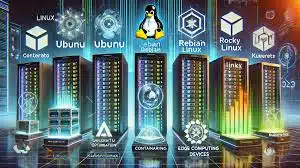- Understanding Power Consumption in Linux Servers and Devices
- Benefits of Reducing Power Usage
- Implementing Power Management Tools
- CPU Frequency Scaling
- Embrace Virtualization
- Optimize System Processes
- Use of Efficient Hardware
- Configure Networking Efficiently
- Leverage Containers for Lightweight Deployments
- Conclusion: The Path Forward
Understanding Power Consumption in Linux Servers and Devices
As technology continues to evolve, the push for energy efficiency remains a priority. In the realm of Linux servers and devices, reducing power consumption not only minimizes operational costs but also aligns with global sustainability goals. By 2025, businesses and individuals alike are likely to demand even greater efficiencies, making it crucial to explore effective strategies for curbing power usage without sacrificing performance.
Benefits of Reducing Power Usage
Lowering power consumption on Linux environments comes with a plethora of advantages. First and foremost, it helps decrease the carbon footprint of data centers and personal devices. This is particularly relevant as regulations around energy efficiency become stricter. Additionally, organizations can enjoy significant cost savings on their electricity bills, which can be redirected toward more critical projects. Moreover, cooling requirements decrease, leading to extended hardware lifespan and decreased maintenance costs.
Implementing Power Management Tools
Linux offers several built-in power management tools that can be effectively leveraged to optimize energy use. Utilities such as cpufreq and TLP can be utilized to adjust the CPU governor settings, enabling systems to scale down their processing power during idle periods. These tools allow for dynamic adjustments based on workload, ensuring that power is not wasted when not necessary.
CPU Frequency Scaling
CPU frequency scaling can dramatically lower energy consumption. By running the CPU at lower frequencies when full power is not required, systems can conserve energy without significant impacts on performance. Configuring your operating system to a more efficient governor, like powersave, can help manage power more effectively.
Embrace Virtualization
Virtualization is a powerful tool for reducing power consumption across Linux servers. By consolidating multiple virtual machines (VMs) on a single physical server, organizations can maximize their resource use. This not only reduces the overall number of physical machines needed but also minimizes power consumption related to hardware overhead, cooling, and management.
Optimize System Processes
Regularly monitoring and optimizing system processes can help mitigate unnecessary power consumption. Tools like htop or top allow admins to identify resource-intensive applications that may not be critical for operation, enabling informed decisions about their management or suspension. Scheduling heavy tasks during off-peak hours can also align resource use with availability, reducing overall energy requirements.
Use of Efficient Hardware
When considering power reduction strategies, upgrading to more energy-efficient hardware can yield significant benefits. Processors designed with efficiency in mind, solid-state drives (SSDs), and energy-star rated power supplies can drastically cut down on energy use. As hardware technology advances, selecting energy-efficient components becomes a wise investment for both performance and sustainability.
Configure Networking Efficiently
Power consumption is often overlooked in network configurations. Employing smarter networking techniques such as link aggregation or configuring network equipment to enter low-power states during periods of inactivity can contribute significantly to overall energy savings. Using ethtool to set down the power state of unused network interfaces is another pragmatic approach.
Leverage Containers for Lightweight Deployments
Using containers instead of traditional virtual machines can lead to substantial reductions in power consumption. Containers share the host OS kernel and resources, leading to lower overhead and faster deployment times. Tools like Docker and Kubernetes help streamline resource allocation, allowing for optimal scaling and efficiency in resource usage.
Conclusion: The Path Forward
As we approach 2025, the emphasis on reducing power consumption in Linux servers and devices will only intensify. Through a combination of power management tools, virtualization, hardware optimization, and intelligent networking, organizations can not only meet regulatory demands but also embrace the future of sustainable technology. By adopting these strategies now, businesses position themselves at the forefront of an energy-efficient era, ensuring that they can thrive in an increasingly eco-conscious marketplace. The journey toward lesser power consumption is not just a necessity; it’s an opportunity for innovation and growth.
